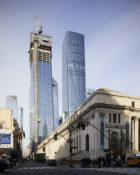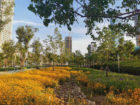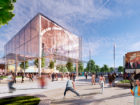New parks and public spaces will open, campus buildings will be inaugurated, and civic treasures will be renovated and reimagined: 2022 has many highlights in store. With climate change top-of-mind, this work demonstrates an array of strategies to decarbonize the built environment, from ecological restoration to adaptive reuse. Here are a few of the milestones we are looking forward to in the coming year.
A pivotal development in Manhattan will be completed

Recent visitors looking westward from Moynihan Train Hall may think they’re seeing double: One Manhattan West, the soaring glass tower completed west of the station in 2019, is being joined by its nearly identical twin.
Within days, Two Manhattan West will reach its full 902-foot height. When the cranes come down, the pair of towers will complete a gateway to the revitalized Far West Side, a district that has undergone a remarkable transformation with the Hudson Yards development and the extension of the High Line.
SOM’s master plan for Manhattan West began with engineering a platform built above the train tracks serving Penn Station. Today, new plazas and public spaces create an unbroken pedestrian pathway through a district that includes commercial space, retail, residences, and a hotel. The glass-enclosed lobbies of One and Two Manhattan West accentuate these new public spaces, opening up sight lines from corner to corner.
A new park will double as green infrastructure

Known as the “city of springs,” Jinan, in eastern China, has a distinctive landscape and ecology defined by its position between the Yellow River and the mountains. Equally important is the city’s industrial heritage as a center for steel production in the mid-20th century.
Today, Jinan is evolving yet again: a large, formerly industrial area is being reimagined as a new central business district. At the center of SOM’s master plan for this development is Jinan Ribbon Park, which weaves a two-kilometer path through the district.

The park, opening next year, forges a deep connection with the landscape that defines the region, with water features that evoke Jinan’s historic springs. Key landscape elements include the Willow Promenade and the Lotus Lake, while a rich palette of local trees and plantings provide areas of respite and improve air quality. The lake serves as an essential piece of green infrastructure: together with a network of rocky ravines, it is designed to capture excess stormwater and mitigate flooding during the rainy summer season.

SOM has also designed new buildings within the park: a transit pavilion, which links the park to a new subway line, and a new retail center. The existing structure of a former steel mill has been repurposed to serve as a cultural and community venue — an apt symbol for the reclamation of this once-industrial area as a place for people to connect with nature.
At Wellesley, the reimagined Science Center will open its doors

For a small liberal arts college, Wellesley is a heavy hitter in the STEM disciplines: it ranks among the top U.S. institutions in the number of women graduates who go on to earn PhDs in the sciences. Now Wellesley is building on this success with a complete transformation of its existing Science Center. The college describes it as the most ambitious project in its modern history.
SOM’s design concept re-envisions the Science Center as a living laboratory, with strong connections to the campus landscape designed by Frederick Law Olmsted. It will link existing facilities — including the observatory, the Global Flora greenhouse project, the arboretum, and the botanic gardens — to create a “village” of science programs. The renovation opens up the fortress-like buildings to the outdoors, and also introduces two new gardens that will be used for teaching. A new cluster of interdisciplinary teaching labs will provide space to explore new pedagogies and put scientific work on display. By the Fall 2022 semester, Wellesley’s new Science Center will be ready to fulfill its role as a crossroads for the campus.
University of Illinois will get its first zero-carbon building

The newest academic building at Illinois’s largest university not only represents the future of technology-driven teaching and learning — it also demonstrates a major step in the university’s commitment to climate action.
The Campus Instructional Facility, or CIF, is designed with the flexibility to accommodate a range of teaching styles, with classrooms ranging in size and capacity from 24 to 500 students. Areas for informal collaboration are located on each floor, and at the center of the building is a signature gathering space: a multi-story staircase framed by soaring structural trusses. Many of these spaces incorporate new technologies for hands-on learning.

An all-electric building, the CIF is on track to achieve net zero operational carbon in its first year of operations — a milestone in the university’s pledge to reach carbon neutrality across its campus by 2050. One of the most significant sustainability features is buried underground: a ground source heat exchange system, a first for the Urbana-Champaign campus, will meet about 65 percent of the building’s total energy demand.
A first-class upgrade for Philadelphia’s historic station will begin

Philadelphia boasts one of America’s great historic railway stations: a neoclassical and Art Deco masterpiece at the center of a neighborhood that is ideally positioned for growth. The ambitious District Plan for Gray 30th Street Station, unveiled in 2016, lays out a vision for a major investment in the station, its infrastructure, and the surrounding area, with the aim to create an equitable, sustainable, and vibrant district centered on transit and expanded public spaces.
Amtrak, Plenary Infrastructure Philadelphia, and SOM have initiated the first major step of the District Plan: enhancing the station building itself. Scheduled to begin construction in 2022, the project will transform the historic station into a model for 21st-century transport hubs. The effort involves restoring the historic interiors, adding new amenities and dining options, improving and expanding office space on the upper levels, and resolving transit and pedestrian flows to create a seamless experience. Outside, a new public space on the south side of the station will provide an expansive gathering place for all Philadelphians to enjoy.
Planning a dynamic, resilient district in Paris

A former industrial zone in eastern Paris may soon become a model for the future of the French metropolis: greener, inclusive, and better connected. Working together with local firm Atelier 2/3/4, SOM has put forward a vision to redevelop the Charenton-Bercy district. As part of the broader Grand Paris initiative to link the capital with its suburbs, this transformative urban master plan will go in for government planning approval early next year.
At the center of the district, a creative workplace building is envisioned as a new tech hub, designed to attract designers and developers for VR, AR, CGI, animation, and video games. The redevelopment also includes a hotel, residential buildings, and a new primary school.

Green spaces weave throughout the reimagined district. A garden bridge will create new connections to the two great amenities nearby — the Bois de Vincennes and the River Seine. A third of the site is reserved for open space, while a further third will be occupied by buildings with green roofs.
Not only will this new quarter be a model for low-energy development once complete, but it will also demonstrate strategies to reduce the carbon impact of construction. The SOM-designed office building has a timber structure, which dramatically reduces the building’s lifetime carbon footprint.
Revitalizing a South Side Chicago neighborhood

As part of the City of Chicago’s INVEST South/West initiative to uplift and revitalize underinvested communities, SOM has teamed up with TnS Studio, McLaurin Development Partners, and Farpoint Development to design a mixed-use entrepreneurial and community hub in the South Side neighborhood of Englewood. Breaking ground next year, Englewood Connect will introduce new spaces and programs to cultivate local businesses and support a thriving, community-based ecosystem.
A new outdoor public plaza called the Green Street Commons will offer an accessible central gathering place, and a nearby pavilion with operable doors and windows will be open year-round, allowing for markets, co-working spaces, exhibitions, and places for the community to gather and engage. A culinary center will provide commercial kitchen space for food-based businesses, and hoop houses will grow fresh produce from local vendors in all seasons.
Alongside new architecture, the plan restores a local landmark: the “castle” firehouse station, built in 1929 and now vacant, will become a multi-purpose community venue.
A library will be remade as a bright, welcoming community hub

Great public libraries are much more than repositories for books; they are places for people to meet and to learn, to engage with ideas and with each other. This broader, civic ideal of what a library can be led the city of Appleton, Wisconsin, to begin a major expansion of its central library. Having outgrown its current facility, the city selected SOM to transform the existing building into a larger, light-filled, more functional space, with renewed amenities and programs for visitors of all ages. Construction will begin next year.
By conserving, rather than demolishing, the existing structure, SOM’s design dramatically reduces the carbon impact of construction. Strategic additions will create a connection to nature and the outdoors. A curving glass facade will create a series of garden pavilions, while new spaces will include a children’s garden and a rooftop terrace. Skylights and outdoor views contribute to a bright, inspiring learning environment.
Introducing new views on San Francisco’s Embarcadero

Since 1991, when the city of San Francisco demolished the infamous Embarcadero Freeway — a monumental ribbon of concrete which severed the city from the bay — this historic stretch of urban waterfront has undergone a dramatic revival. Now, one of the last pieces of a long revitalization is nearly complete: One Steuart Lane, a refined residential tower, has risen on the last remaining development site on the Embarcadero, with a design that makes the most of unparalleled views across the bay.

The design centers on creating a seamless connection between indoors and outdoors — taking a classic concept for California living and applying it at the scale of a high-rise. Spacious outdoor terraces wrap around the building, breaking up its vertical rise into horizontally-proportioned volumes that relate to the panoramic waterfront landscape they face. Bay-facing residences are enclosed with enormous structural-glass sliding doors. SOM’s engineering expertise informed the design of the wraparound terraces, which cantilever as much as 20 feet.
Nearing full completion in early 2022, One Steuart Lane sets the bar for high-rise living in San Francisco that offers an unmistakable sense of place.




